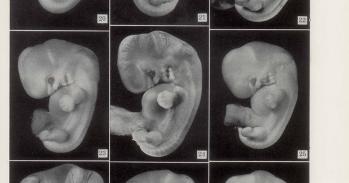
New research reveals that the sperm cells of adolescent boys have more than six times the rate of DNA mutations as the equivalent egg cells in adolescent girls, resulting in higher rates of DNA mutation being passed down to children of teenage fathers. The findings suggest that the risk of birth defects is higher in the children of teenage fathers as a consequence.
New research reveals that the sperm cells of adolescent boys have more than six times the rate of DNA mutations as the equivalent egg cells in adolescent girls, resulting in higher rates of DNA mutation being passed down to children of teenage fathers. The findings suggest that the risk of birth defects is higher in the children of teenage fathers as a consequence.
Sperm production in boys may undergo dozens more cell cycles – and therefore DNA copying errors – than has previously been suspected
Peter Forster
A genetic study of over 24,000 parents and their children has shown that the children of teenage fathers have unexpectedly high levels of DNA mutations.
Mutations, the result of DNA copying errors during cell division, can occur in different cells of the body and at different times during life. Some, such as those that occur in 'germ cells' – which create sperm or eggs – cause changes affecting the individual's offspring.
Previously, it was thought that germ cells in both boys and girls go through a similar number of cell divisions, and should have roughly the same rates of DNA mutation by the time an individual reaches puberty.
Now, a new study shows that the number of cell divisions – and consequently DNA mutation rates – experienced by the germ cells of teenage boys is six times higher than for those of girls, and that DNA mutations passed down to the children of teenage fathers are higher as a result.
Researchers say the increased DNA mutations in the reproductive cells of adolescent boys could explain why the children of teenage fathers have a higher risk for disorders such as autism, schizophrenia and spina bifida.
Men produce germ cells throughout their lives, and it was previously assumed that DNA mutation in germ cells increased as men get older – more cell division and greater DNA mutation has occurred as men age.
However, the latest results show that the germ cells of adolescent boys are an exception to this aging rule.
Researchers have shown that male germ cells go through around 150 cell divisions by puberty, compared to the 22 cell divisions experienced by female oocytes (immature egg cells). This raises in tandem the rates of DNA mutation incurred by cell division in the germ cells of teenage boys – creating higher chances of hereditary disease in children conceived by adolescent fathers.
The researchers say that this could be the result of unknown cell divisions during male childhood or a spike in DNA error during puberty – although the reasons are currently unclear.
Prior to the new findings, male germ cells were thought to undergo 30 divisions by puberty. The results overturn previous notions that the younger the man, the less cell division and the less risk of DNA mutations in germ – and later sperm – cells.
In fact, researchers say that – while more work needs to be done – these initial findings furthermore indicate that sperm cells in teenagers have approximately 30% higher rates of DNA mutation than those of young men in their twenties, and that teenage boys have similar levels of DNA mutation in their sperm cells to men aged in their late thirties and forties.
“It appears that the male germ cells accumulate DNA errors unnoticed during childhood, or commit DNA errors at an especially high level at the onset of puberty. However, the reason for this is not yet clear,” said geneticist Dr Peter Forster, a Fellow of Murray Edwards College and the McDonald Institute at the University of Cambridge, who conducted the study with colleagues from the Institute of Forensic Genetics in Münster, Germany.
“Possibly the DNA copying mechanism is particularly error-prone at the beginning of male puberty. Or, sperm production in boys may undergo dozens more cell cycles – and therefore DNA copying errors – than has previously been suspected,” he said.
Either way, the textbooks may well need to be rewritten as a result of the new findings, says Forster, which are published today in the journal Proceedings of the Royal Society B.
The research team used DNA from blood and saliva samples taken from 24,097 normal parents and their validated biological children from areas of Germany, Austria, the Middle East and West Africa.
The researchers analysed a type of DNA known as ‘microsatellites’ – simple, repetitive sequences of DNA that only mutate as a result of cell replication, providing the team with a natural ‘cell-cycle counter’ which they used to track the number of times a cell divides, and consequently the rate of mutations through DNA copying error.
Through comparative analysis, the research team discovered the increased DNA mutations in children of teenage fathers, and that mutations are six times higher in male sperm cells during onset of puberty than in female oocytes.
While this means that the children of teenage fathers have increased chance of abnormality, Forster points out that the risk is still very small: perhaps around 2% as opposed to a general average abnormality risk of 1.5%.
The team hope to develop the cell-cycle counter technique used in the study and apply it to cancers, in order to better estimate the age of such conditions in individuals, and the number of cell divisions between the initial cellular malfunction and tumour growth.
The text in this work is licensed under a Creative Commons Licence. If you use this content on your site please link back to this page. For image rights, please see the credits associated with each individual image.





